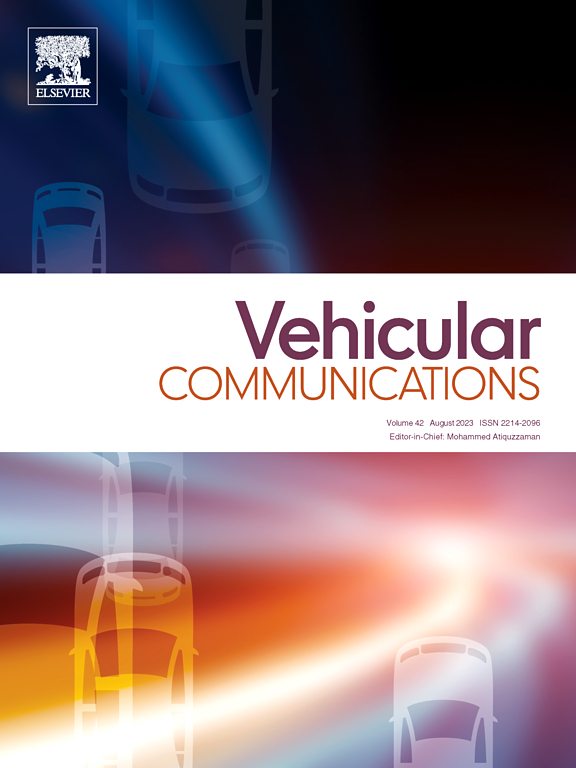在车载边缘计算网络中使用高效的隐私保护认证增强安全性和信任度
IF 6.5
2区 计算机科学
Q1 TELECOMMUNICATIONS
引用次数: 0
摘要
车联网(IoV)对智能交通系统(ITS)的安全性、安全性和服务提出了更高的要求。频繁的广播消息间隔和专用短程通信(DSRC)使得在如此短的时间内验证消息极具挑战性。此外,现有的认证协议由于通信和计算开销大,无法满足环境的要求。此外,还提出了轻量级认证方案来解决这个问题;然而,这样的尝试不能提供一个复杂的解决方案来处理高级安全需求,并受到准确性问题的影响。本文介绍了一种双因素身份验证协议,该协议使用轻量级加密操作,如单向散列和异或(XOR),具有可接受的效率和安全性。这些身份是使用物理不可克隆函数(puf)、密码和随机值生成的,以确保双因素身份验证。该提案通过正式的安全分析进行严格验证,确认该协议具有不可追踪性,匿名性,保护密钥保密性,并且可以抵抗IoV领域的众所周知的攻击。性能分析证实了该方案的鲁棒性和可靠性,在计算、通信和支持更多安全需求方面能耗低43.31%,是一种可行的车联网解决方案。本文章由计算机程序翻译,如有差异,请以英文原文为准。

Enhancing security and trust using efficient privacy-preserving authentication in vehicular edge computing networks
The Internet of Vehicles (IoV) requires advanced safety, security, and services in Intelligent Transportation Systems (ITS). Frequent broadcast message intervals and Dedicated Short-Range Communication (DSRC) make validating messages in such short timeframes extremely challenging. Additionally, current authentication protocols cannot meet the demands of the environment due to high communication and computational overheads. Furthermore, lightweight authentication proposals have been put forth to solve the problem; however, such attempts cannot provide a sophisticated solution that can handle advanced security needs and suffer from accuracy issues. This article presents a two-factor authentication protocol using lightweight cryptographic operations such as one-way hashing and exclusive OR (XOR) with acceptable efficiency and security. The identities are generated using Physically Unclonable Functions (PUFs), passwords, and randomized nonces to ensure two-factor authentication. The proposal is rigorously verified through formal security analysis, confirming that the protocol is untraceable, anonymous, protects key secrecy, and is resistant to well-known attacks in the IoV domain. The performance analysis confirms its robustness and reliability, with 43.31% low energy consumption in terms of computation, communication, and support for more security requirements, making it a feasible solution for the IoV domain.
求助全文
通过发布文献求助,成功后即可免费获取论文全文。
去求助
来源期刊

Vehicular Communications
Engineering-Electrical and Electronic Engineering
CiteScore
12.70
自引率
10.40%
发文量
88
审稿时长
62 days
期刊介绍:
Vehicular communications is a growing area of communications between vehicles and including roadside communication infrastructure. Advances in wireless communications are making possible sharing of information through real time communications between vehicles and infrastructure. This has led to applications to increase safety of vehicles and communication between passengers and the Internet. Standardization efforts on vehicular communication are also underway to make vehicular transportation safer, greener and easier.
The aim of the journal is to publish high quality peer–reviewed papers in the area of vehicular communications. The scope encompasses all types of communications involving vehicles, including vehicle–to–vehicle and vehicle–to–infrastructure. The scope includes (but not limited to) the following topics related to vehicular communications:
Vehicle to vehicle and vehicle to infrastructure communications
Channel modelling, modulating and coding
Congestion Control and scalability issues
Protocol design, testing and verification
Routing in vehicular networks
Security issues and countermeasures
Deployment and field testing
Reducing energy consumption and enhancing safety of vehicles
Wireless in–car networks
Data collection and dissemination methods
Mobility and handover issues
Safety and driver assistance applications
UAV
Underwater communications
Autonomous cooperative driving
Social networks
Internet of vehicles
Standardization of protocols.
 求助内容:
求助内容: 应助结果提醒方式:
应助结果提醒方式:


